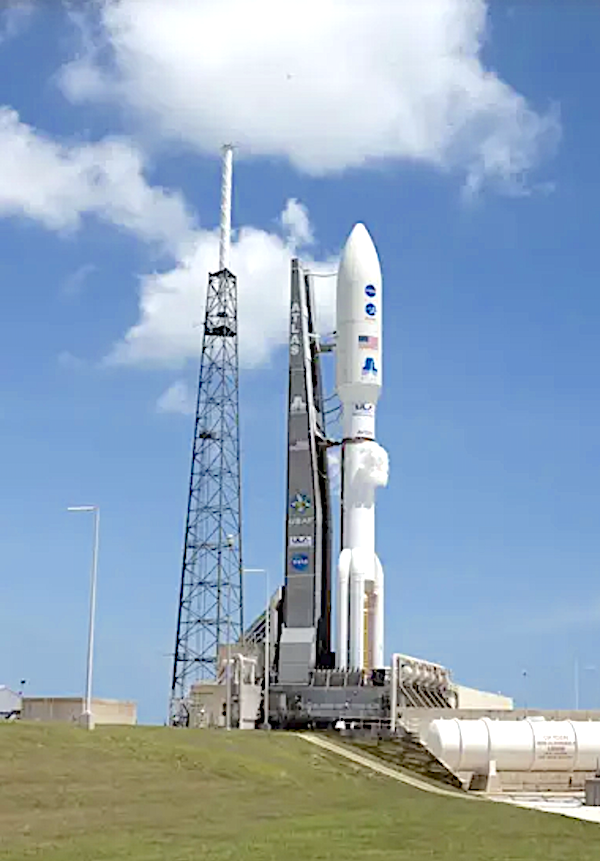
The projected launch of ULA’s Amazon Project Kuiper has now been filed in the Yet to be Determined date in April.
ULA’s Amazon Project Kuiper now set for April 28 launch
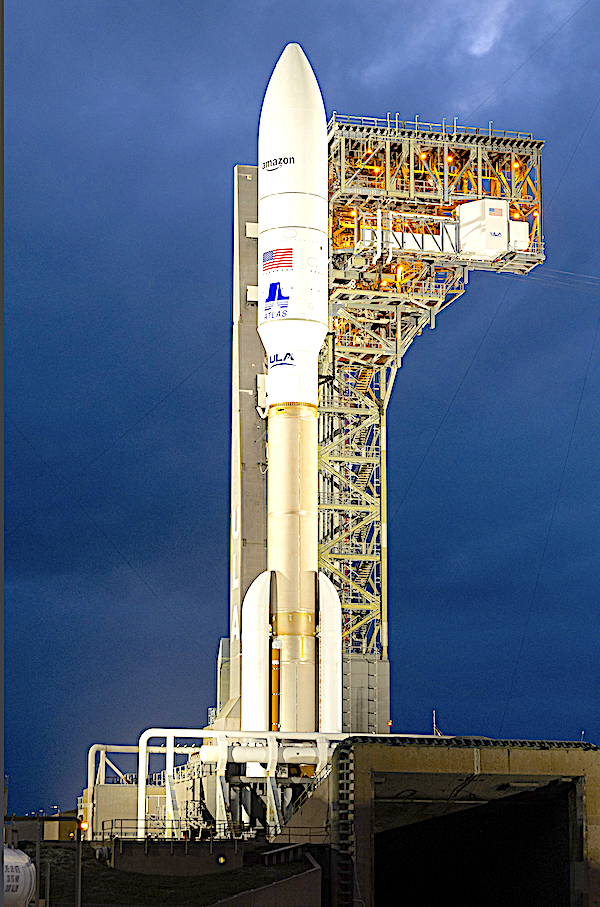
ULA’s launch date of Amazon Project Kuiper now is rescheduled to April 28. The inaugural launch of Amazon’s Project Kuiper will use a United Launch Alliance (ULA) Atlas V rocket to deliver the first satellites of the constellation into low Earth orbit (LEO) at a cost of $153 million.
The mega constellation of satellites in Low Earth Orbit that will offer broadband internet access, this constellation will be managed by Kuiper Systems LLC, a subsidiary of Amazon. This constellation is planned to be composed of 3,276 satellites. The satellites are projected to be placed in 98 orbital planes in three orbital layers, one at 590 km, 610 km and 630 km altitude.
United Launch Alliance (ULA) is a joint venture of Lockheed Martin Space Systems and Boeing Defense, Space & Security. ULA was formed in December 2006 by combining the teams at these companies which provide spacecraft launch services to the government of the United States. ULA launches from both coasts of the US. They launch their Atlas V vehicle from LC-41 in Cape Canaveral and LC-3E at Vandeberg. Their Delta IV launches from LC-37 at Cape Canaveral and LC-6 at Vandenberg.
ULA plans Amazon Project Kuiper’s launch on Monday
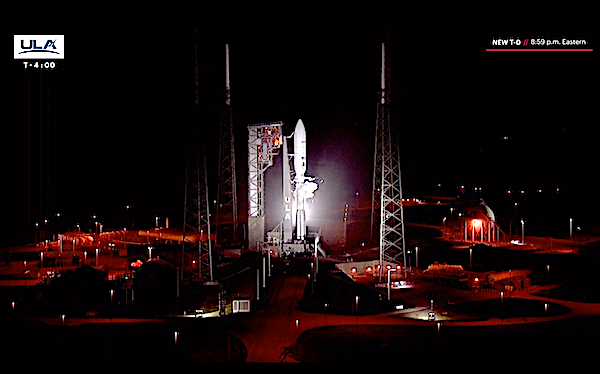
The next date for ULA’s launch of Project Kuiper now is scheduled for Monday, April 14 from 4:00 PM to 8:34 PM ET. Liftoff of the Kuiper 1 mission will occur from Space Launch Complex (SLC)-41 at Cape Canaveral Space Force Station, Florida.
Project Kuiper’s satellite payload will be the heaviest payload ULA’s Atlas V rocket has ever flown. To accommodate it, ULA will be flying Atlas V in its most powerful configuration. The launch will cost $153 million
Project Kuiper is a mega constellation of satellites in Low Earth Orbit that will offer broadband internet access, this constellation will be managed by Kuiper Systems LLC, a subsidiary of Amazon. This constellation is planned to be composed of 3,276 satellites. The satellites are projected to be placed in 98 orbital planes in three orbital layers, one at 590 km, 610 km and 630 km altitude.
The Atlas V 551, manufactured by United Launch Alliance established in 2006, undertook its inaugural launch on 01/19/2006, is non-reusable and is active.
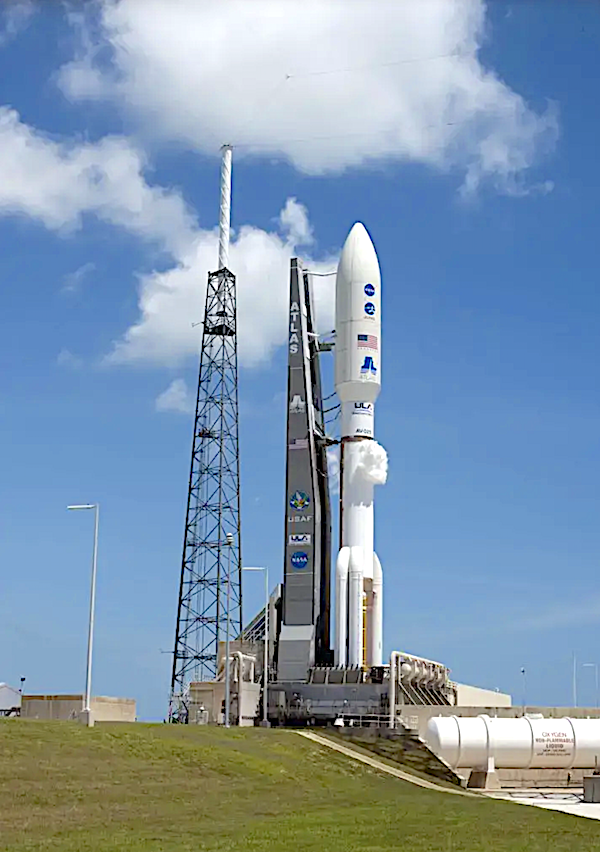
Atlas V 551 has 14 successful launches and 0 failed attempts, with a cumulative tally of 14 launches, currently with 9 pending launches in the pipeline.
Atlas V is an expendable launch system in the Atlas rocket family. It was formerly operated by Lockheed Martin and is now operated by United Launch Alliance (ULA), a joint venture with Boeing. Each Atlas V rocket uses a Russian-built RD-180 engine burning kerosene and liquid oxygen to power its first stage and an American-built RL10 engine burning liquid hydrogen and liquid oxygen to power its Centaur upper stage. The RD-180 engines are provided by RD Amross, while Aerojet Rocketdyne provides both the RL10 engines and the strap-on boosters used in some configurations. The standard payload fairing sizes are 4 or 5 meters in diameter and of various lengths. Fairings sizes as large as 7.2 m in diameter and up to 32.3 m in length have been considered. The rocket is assembled in Decatur, Alabama and Harlingen, Texas.
ULA scrubs Amazon’s Kuiper 1 mission a No Go due to nasty weather conditions

“The stubborn cumulus clouds and persistent winds make liftoff not possible within the available window,” according to ULA Launch Director Eric Richards. The Amazon Kuiper 1 mission was a NO GO. Launch Weather Officer Brian Belson, United Launch Alliance said, “The stubborn cumulus clouds and persistent winds make liftoff not possible within the available window.”
At the start of a two hour window ending at 9:00 pm EDT (01:00 UTC on April 10) the launch of a United Launch Alliance Atlas V rocket carrying the Kuiper 1 mission for the Amazon’s Project Kuiper was scrubbed today due to inclement weather.
The U.S. Space Force’s 45th Weather Squadron showed only a 55 percent chance of acceptable conditions, with the cumulus cloud rule and the liftoff winds being primary concerns. The forecast deteriorated further to just a 20 percent chance of acceptable conditions during the launch day itself before the scrub. The earliest possible attempt is now on Thursday, April 10 after approval on the range. The launch forecast improves to 90 percent favorable for the backup launch day on Thursday, April 10, with the cumulus cloud rule being the only concern.
Apr 09 17:41
SCRUB. ULA Launch Director Eric Richards has announced that we will not continue with countdown operations today.
Weather is observed and forecast NO GO for liftoff within the remaining launch window at Cape Canaveral this evening, according to Launch Weather Officer Brian Belson. The stubborn cumulus clouds and persistant winds make liftoff not possible within the available window.
Launch Weather Officer Brian Belson continues to brief the ULA launch leadership as new observations refresh on the radar. There remains a slight chance the clouds could clear.573are
Apr 09 17:21
NEW LAUNCH TIME. ULA Launch Director Eric Richards has instructed the team to coordinate a new launch time of 8:59 p.m. EDT (0059 UTC). That is near the very end of the available launch window today. We continue to hope the weather situation will clear.
Amzon’s Kuiper 1 mission is ready, set… to go, “this is just the start of our journey”
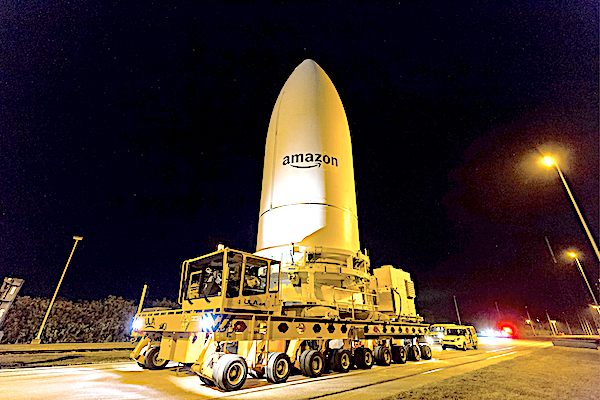
Photo by United Launch Alliance, April 2, 2025.
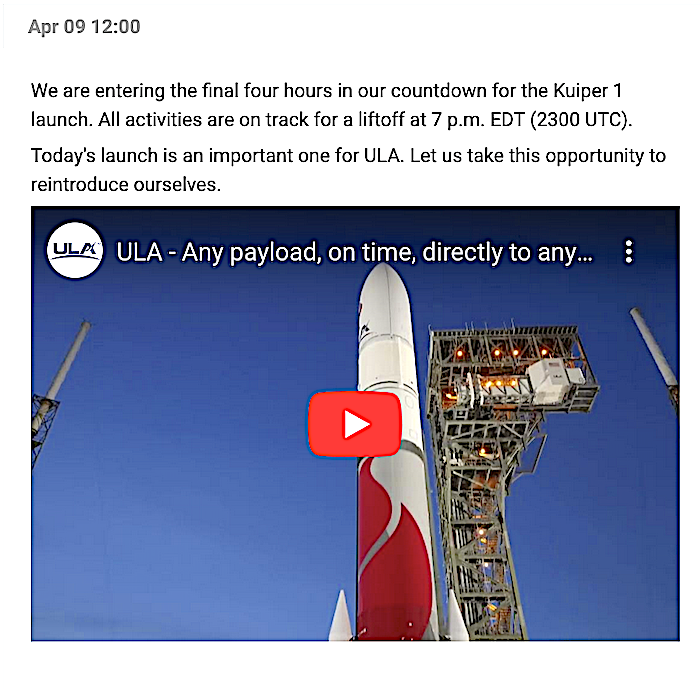
United Launch Alliance (ULA) is readying the Atlas V 551 rocket to deliver the first satellites into space for Amazon’s Project Kuiper, an advanced low Earth orbit (LEO) constellation that will bring fast, reliable internet to customers and communities around the world.
Amazon hasn’t released many details about the individual satellites, and companies are competing to bring hundreds and thousands of smallsat constellations.
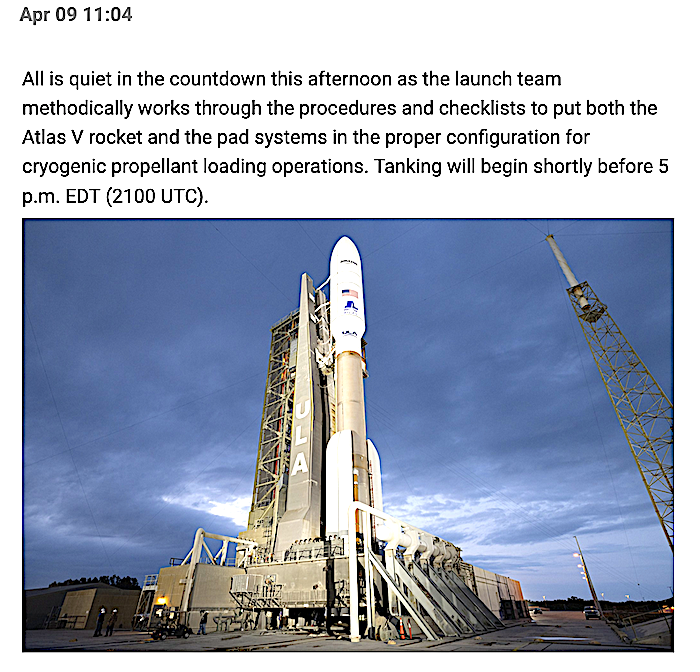
Liftoff of the Kuiper 1 mission will occur from Space Launch Complex (SLC)-41 at Cape Canaveral Space Force Station, Florida, on Wednesday, April 9. Project Kuiper’s satellite payload will be the heaviest payload ULA’s Atlas V rocket has ever flown. To accommodate it, ULA will be flying Atlas V in its most powerful configuration. The launch will cost $153 million.
A three-hour launch window opens at 6 p.m. EDT (2200 UTC). According to weather officials, there’s a 55% chance of favorable weather conditions at the time of the launch. Officials are monitoring weather conditions with concerns related to Cumulus Cloud Rule, Liftoff Winds. The forecast calls for a temperature of 71°F, scattered clouds, 32% cloud cover and a wind speed of 20mph.
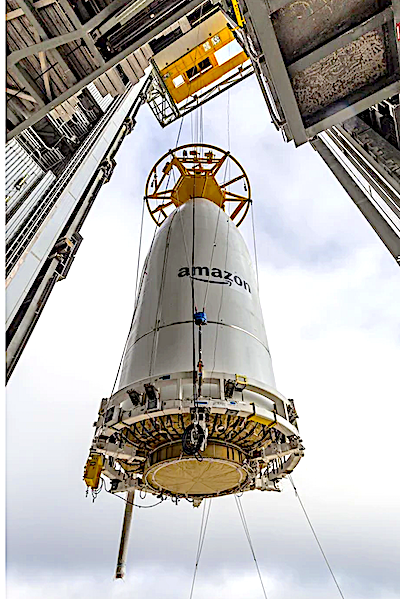
In a news release Rajeev Badyal, vice president of Project Kuiper said,“We’ve designed some of the most advanced communications satellites ever built, and every launch is an opportunity to add more capacity and coverage to our network.
“We’ve done extensive testing on the ground to prepare for this first mission, but there are some things you can only learn in flight, and this will be the first time we’ve flown our final satellite design and the first time we’ve deployed so many satellites at once.”
“No matter how the mission unfolds, this is just the start of our journey, and we have all the pieces in place to learn and adapt as we prepare to launch again and again over the coming years.”
This launch begins a new chapter in the commercial launch industry as Amazon partners with ULA to deliver a majority of its satellites into orbit. The Kuiper 1 mission is the first of 46 launches by ULA for the Kuiper constellation using eight Atlas V and 38 Vulcan rockets.
Project Kuiper is built around an initial constellation of more than 3,200 advanced LEO satellites. Its mission is to provide fast, affordable internet to customers and communities around the world, including those unserved or underserved by traditional connectivity technologies. The system has the capacity, performance, and flexibility to serve a wide range of customers, from individual households to schools, hospitals, businesses, government agencies and other organizations operating in places without reliable connectivity.
ULA began preparations for the Kuiper 1 launch on Feb. 24 by standing up the Atlas V first stage aboard the mobile launch platform (MLP) at the Vertical Integration Facility (VIF), located adjacent to the SLC-41 pad. The subsequent days saw the full complement of five side-mounted solid rocket boosters (SRBs) affixed to Atlas to provide maximum launch performance.
The Centaur upper stage, which will carry the payload into the prescribed orbit, was lifted into the VIF on March 14. Kuiper 1 marks the 250th Centaur launch atop an Atlas rocket and the 275th flight overall for the venerable upper stage.
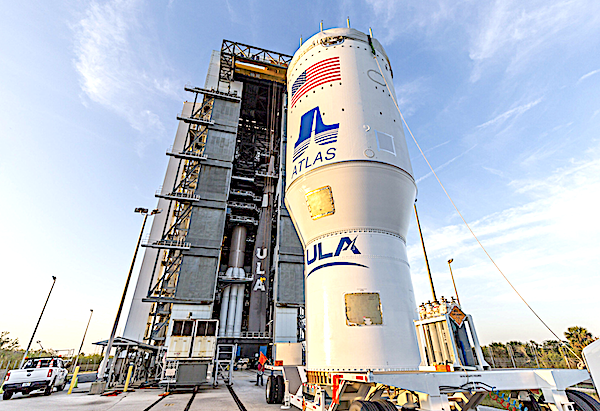
Centaur has successfully launched spacecraft to every planet in the solar system, delivered dozens of other scientific and weather satellites, carried critical assets into space for U.S. national security, and enabled commercial missions including support of NASA’s Commercial Crew Program.
While the rocket stacking activities were ongoing, Amazon technicians were installing the satellites onto a specialized dispenser system inside Project Kuiper’s satellite processing facility at the Kennedy Space Center. Once the craft were all set in place, the Atlas V’s composite payload fairing enclosed Kuiper 1 for its historic journey.
On March 31, ULA transported Kuiper 1 from the satellite processing facility to the VIF where it became one of the heaviest payloads ever hoisted atop an Atlas rocket. The payload is supported through attachment and reinforcement elements for the ride to orbit.
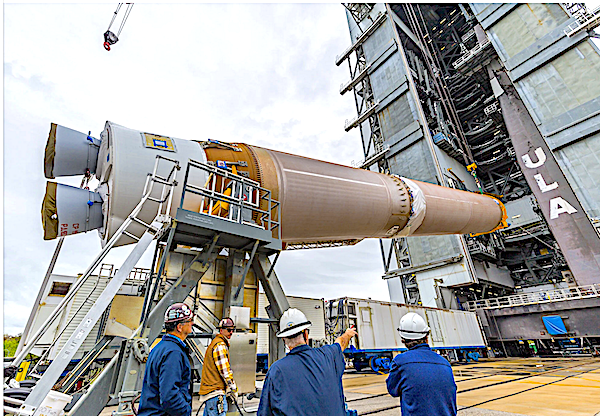
ULA made several modifications and design changes to accommodate the mass and size of thve Kuiper payloads. That included enhancements to the ground handling equipment needed to transport the encapsulated payload during the move from Amazon’s building to ULA’s VIF and the hardware used to hoist the payload atop the Atlas V for connection.
Now standing 205 feet (62.5 m) tall, the fully assembled Atlas V rocket features a longer length payload fairing than standard to carry as many satellites as possible. This will be only the 9th time in 102 launches of Atlas V to use the larger fairing.
The Atlas V 551, weighing 1.3 million pounds (589,000 kg) once fueled for launch, generates a combined thrust of 2.7 million pounds (12 megaNewtons) from its main engine and five SRBs. The rocket will embark on a northeasterly trajectory and onboard guidance will target a near-circular LEO of approximately 280 miles (450 km) and 51.9 degrees inclination.
L-1 – ULA Atlas V readies for Wednesday Kuiper 1 mission for Amazon’s Project Kuiper
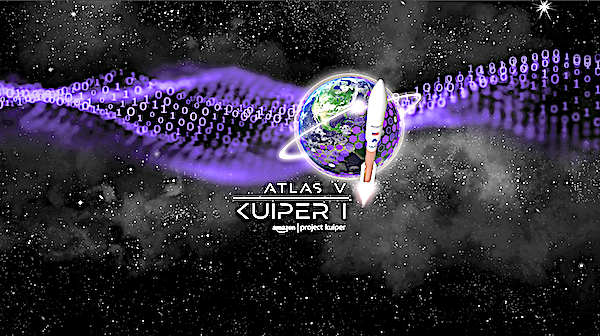
Everything continues to progress towards the ULA Atlas V launch carrying the Kuiper 1 mission for Amazon’s Project Kuiper. The mission is planned to lift off on Wednesday, April 9 from Space Launch Complex-41 at Cape Canaveral Space Force Station in Florida. The launch is planned for 7 p.m. EDT. Today’s forecast shows a 55 percent chance of favorable weather conditions for launch.
Launch Forecast Summary:
Overall probability of violating weather constraints: 45%
Primary concerns: Liftoff Winds, Cumulus Cloud Rule
Overall probability of violating weather constraints for 24-hour delay: 10%
Primary concern: Cumulus Cloud Rule
Amazon’s Kuiper-1 launch brought forward
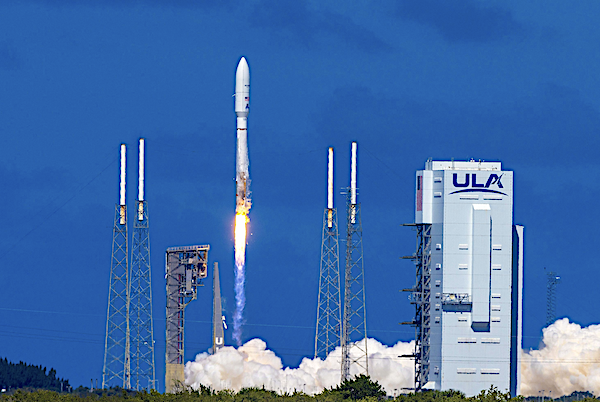
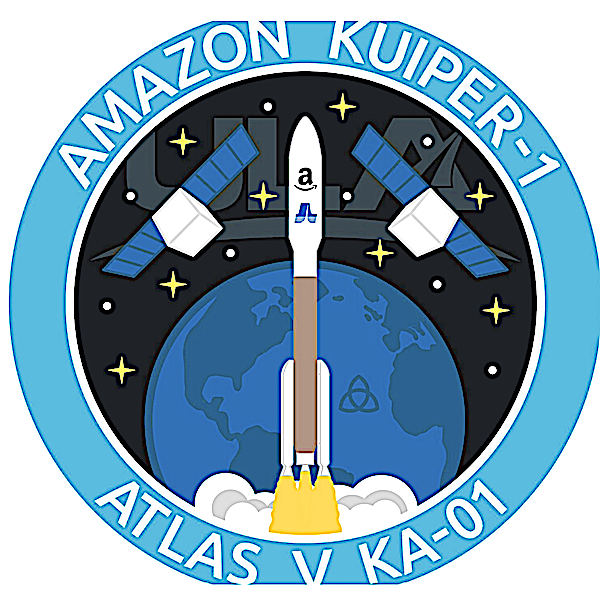
This will be the first operational launch for Amazon’s giant Project Kuiper mega-constellation, and it is expected to launch in the next two months aboard an Atlas V 551 rocket. This will be the first launch for the ULA rocket this year.
ULA had expected the launch slot to handle to be the USSF-106 mission onboard a Vulcan rocket and it began preparing the rocket in October 2024, following its second certification mission, dubbed Cert-2. Gary Wentz, vice president of Government and Commercial Programs at ULA said the government identified that payload as “their highest priority mission,” so they worked to get quickly ready for that.
However, the USSF-106 mission is not yet ready. “And so, we elected to go ahead and LVOS (Launch Vehicle on Stand) pause that booster to get that work off the critical path so that we’re prepared to launch, whether it was 106 or Kuiper,” added Wentz.
It seems Kuiper has won the race, and the rocket will handle a large number of satellites, possibly around 27 although the precise number has yet to be confirmed.
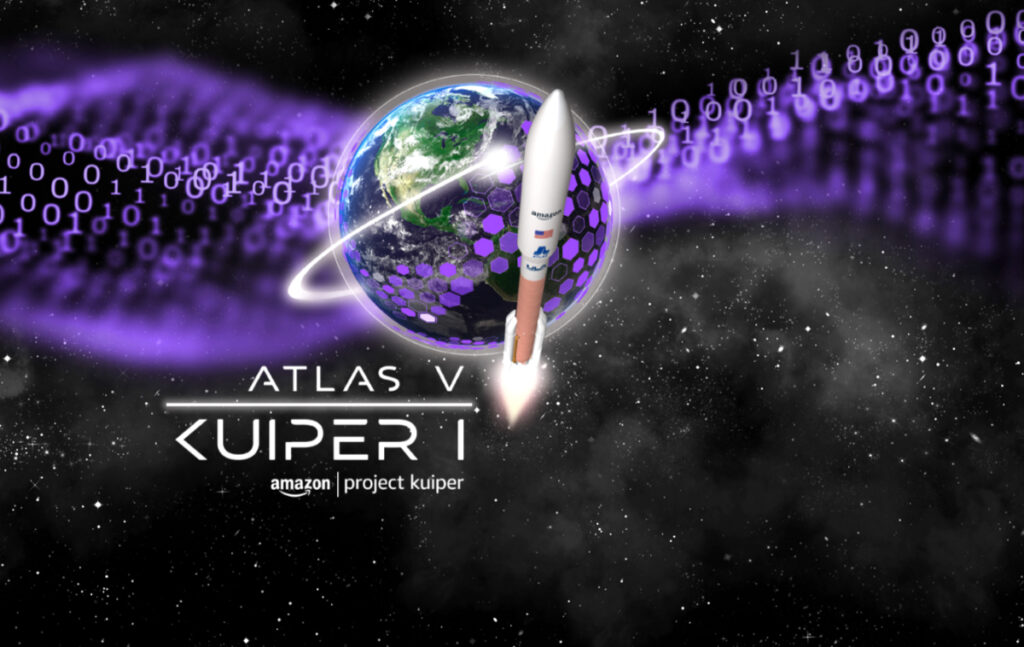
Amazon hasn’t said how many satellites it plans to launch on the Kuiper-1 mission although it has announced on social media that “another batch” of its Kuiper broadband production satellites was “on its way to Cape Canaveral.”
Amazon’s Kuiper fleet is planned to have a total of 3,236 satellites in low Earth orbit. Kuiper has 46 launches booked with ULA. Amazon has also purchased 18 launches on Arianespace’s Ariane 6 rocket, plus 12 launches on Blue Origin’s New Glenn rocket, with options to add another 15 on top of that; and three launches on SpaceX’s Falcon 9 rocket.
ULA has confirmed that it plans on launching “quite a few” Kuiper missions this year, using both the Atlas rocket as well as the more powerful Vulcan craft. Wentz said the first Vulcan rocket planned to launch Kuiper satellites is currently in production.

